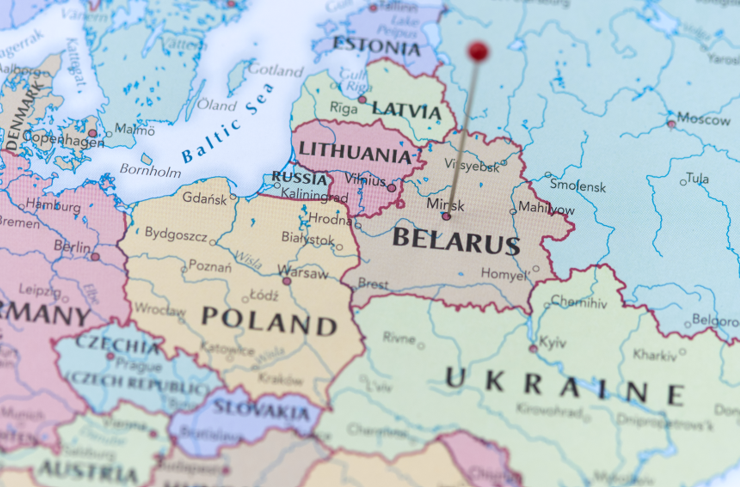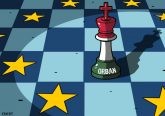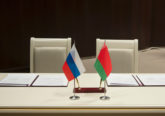Belarus, a country of 9.2 million people in Eastern Europe, is portrayed in Western media and diplomatic circles in a simplistic and unnuanced way: in addition to its decades-long description as Europe’s last dictatorship, it is now also perceived as a Russian satellite state, springboard for hybrid threats, including illegal migration, to the EU, and a co-aggressor in Moscow’s war on Ukraine.
Such perceptions particularly dominate the discourses and shape the policies towards Belarus of its immediate neighbours among EU and NATO member states – Poland, Lithuania, and Latvia. Indeed, tensions on Belarus’s borders with these states have risen sharply in recent years. Since 2020, Warsaw, Vilnius, and Riga have spearheaded the introduction of harsh Western sanctions and border closures, which now amount almost to a semi-blockade of Belarus, and have significantly expanded their military capabilities close to the Belarusian border. For its part, Minsk has stopped preventing illegal migrants from crossing the EU border from its territory and requested the deployment of Russian tactical nuclear weapons in Belarus.
These and other escalatory developments have grabbed recent media headlines. But there have been few serious attempts in the West to look beyond the headlines and better understand the nature of the tensions with Minsk. In particular, why has Belarus, which only a few years ago pursued rapprochement with the West as a foreign policy priority, refused to take sides in the Russian-Western confrontation, and promoted itself as a “Switzerland of Eastern Europe” – changed course so dramatically towards the West? And, more importantly, are there lessons from this transformation that can help deescalate tensions and avoid further crises on the Belarus-EU borders?
Wrong analytical lenses
In the West, the mainstream explanation sounds simple: the personality of Aleksandr Lukashenko, who has ruled the country with an iron fist for almost 30 years, and his desire to remain in power explain Belarus’s hostility to the West. In academic terms, such interpretations amount to constructivist arguments about the personal characteristics and preferences of political leaders as the central determinant of policymaking.
To be sure, Belarus has an authoritarian political system with super-presidential powers in both domestic and foreign policy. This is why, in 2005, then US Secretary of State Condoleezza Rice famously dubbed the country Europe’s “last true dictatorship”. More recently, and especially since the mass Belarusian protests following the 2020 elections, the label has become even more powerful in shaping Western perceptions of Minsk (although the country is no longer seen as the “last” European dictatorship, as the spotlight has shifted to Russia). Belarus’s role in the 2021 migration crisis on its borders with Poland and the Baltic states, and in Russia’s war on Ukraine, is in many eyes entirely consistent with these perceptions, especially as the “democracy vs. autocracy” dichotomy is increasingly used as an explanatory framework for understanding growing tensions in international relations.
According to this logic, the a priori malign, undemocratic Lukashenko regime is profoundly anti-Western and will therefore take every opportunity to harm Western interests, while serving those of fellow autocrats, like Russia and China. This premise has become so firmly ingrained in Western political thinking that few appear to question it.
However, one does not need to scratch deep beneath the surface to see that such normative perceptions contradict basic empirical evidence and are, therefore, counterproductive for designing a sound policy towards Minsk.
Belarus has been authoritarian since the 1996 referendum that amended the country’s constitution to create a super-presidential republic with almost no effective separation of powers. Already then, the EU and the US began sanctioning Belarus for democratic decline and human rights abuses. Since then, almost every major election campaign in Belarus has led to new sanctions. The Lukashenko government, in turn, responded with harsh anti-Western rhetoric, expulsions of Western diplomats, and restrictions on access to Belarus for Western NGOs and educational projects. However, these recurring developments did not prevent the sides from repeatedly deescalating tensions and even coming close to normalising relations, first in 2009-2010 and later in 2016-2020.
Most revealingly, with each thaw in relations between Belarus and the West, there would be a gradual, not irreversible, but still visible improvement in the situation of human rights and political freedoms in Belarus. Cooperation with the West, including on economic and regional security issues, would to the satisfaction of both sides, while the rhetoric in Minsk towards the EU and the US would become decidedly friendlier. And all this would happen under the watch of the same Lukashenko.
Thus, it seems obvious that limiting the causal analysis of changes in Belarusian foreign policy to the Lukashenko factor alone misses the point. It is an oversimplification of the Belarusian geopolitical reality and the constraints and incentives that drive decision-making in Minsk.
Foreign policy hedging
Dominant Western perceptions of Belarusian international conduct appear to reflect a larger analytical problem – the pervasive failure of practitioners and experts alike to understand hedging as an underlying foreign policy logic of weaker states in complex geopolitical environments. As a result, rather than helping hedgers to perfect the skill so that the West could benefit from it, the latter often tends to undermine them, which ultimately only impairs Western strategic standing and security interests. The Belarus case serves as a vivid example.
The idea of (strategic) hedging has become increasingly prominent in the international relations literature. Yet, and strangely enough, it is almost never applied to the analysis of former Soviet republics, especially Eastern European ones. While different interpretations of hedging exist, several key features distinguish the concept from other foreign policy strategies.
Hedging emerges as a non-linear policy response to external uncertainties aimed at minimising risks while maximising opportunities. It is most often used by structurally weaker states in geopolitically contested contexts. Rather than making a clear choice between the more conventional options of bandwagoning with or balancing against stronger actors, hedgers try to master the art of simultaneously combining close cooperation with these actors and resistance to their pressures. Typically, such a combination involves several different domains – diplomatic, military, economic, informational, and cultural. An overarching and often emphatic element of a hedger’s portfolio can be called “bridging politics”. That is, a hedger strives to disengage itself from tensions between competing geopolitical powers and to promote, at least rhetorically, ideas for bridging their differences.
My doctoral research established that between 2008 and 2020 Belarusian international conduct was a clear example of foreign policy hedging. Importantly, both the assertiveness and scope of its hedging portfolio expanded over time as the Lukashenko government gained experience and managed to slowly diversify its international options thanks to improving relations with the West. It could do so even under the conditions of a formal military-political alliance with Russia.
Belarus’s hedging had a positive impact on regional security in Eastern Europe, which was in line with Western interests. Arguably, the most consequential element of its hedging portfolio was the situational neutrality in the Russian-Ukrainian conflict, which Belarus maintained until late 2021. Notwithstanding its alliance commitments to Russia, Minsk offered its territory as a neutral venue for peace talks to resolve the conflict in Ukraine in 2014-2020. It hosted numerous negotiations of different status and design, including the Normandy Summit in February 2015 and regular talks within the OSCE Trilateral Contact Group. All this made it easier for the Lukashenko government to stay out of the conflict and, noteworthily, amounted to a de facto Belarusian security guarantee for Ukraine.
Hedgers need room for manoeuvre
By late 2020, however, Belarus’s hedging portfolio began to shrink and has now all but disappeared, giving way to a policy of bandwagoning with Moscow. Two main factors contributed to this dynamic by creating the worst of all possible worlds for any hedger – that is, when the foreign policy options and room for manoeuvre that Minsk made full use of in 2015-2020 were quickly evaporating.
The first factor was hard to avoid, as it represented the rapid deterioration of the overall geopolitical environment around Belarus. Tensions between Russia and the West began to rise after 2013-14, immediately putting Minsk between a rock and a hard place. But until 2021, hostilities remained relatively modest and even encouraged hedging as the optimal foreign policy strategy for Belarus. Once the geopolitical tensions became extreme, the room for manoeuvre that a smaller in-between state could enjoy automatically shrank, making it impossible for Minsk to simply continue to apply the same hedging portfolio in its entirety.
However, the Lukashenko government has an objective interest in preserving at least some elements of the portfolio so that it can begin to expand it again when circumstances permit. Unfortunately, this is where the second factor came into play – Western economic sanctions and political pressures. The EU and the US began imposing sanctions after the Belarusian presidential elections in August 2020, and they have been repeatedly expanded in response to new negative developments, but also because previous sanctions had not achieved their stated goals.
Even before 2020, EU sanctions against Belarus were the most comprehensive CFSP sanctions regime in force, but they were targeted, not sectoral. Now they are destroying the foundations that hold the economies and societies of Belarus and the EU together. As a result, they are not just suspending cooperation as in the past, but destroying the very rationale for both sides to salvage as much cooperation as possible in the hope of a better future. The fact that after 2020 Ukraine also began to join Western sanctions against Minsk, even though not all of them, was particularly bad for the prospects of Belarusian hedging.
Western diplomats use the normative argument to justify the unprecedented sanctions against Minsk (even though, in fact, their imposition appears to have only worsened the human rights situation on the ground). In geopolitical terms, however, the sanctions, combined with political pressures and the severing of most diplomatic channels of communication, have left Moscow as the only game in town for Belarus, effectively dashing its hopes of preserving at least some elements of its hedging portfolio. On top of that, already in early 2021, both Kyiv and most Western capitals refused to consider Minsk as a venue for diplomatic talks, which deprived Belarus of the last argument in favour of preserving its situational neutrality. As a result, it was hardly surprising that on 24 February 2022, some Russian troops where assaulting Ukraine from the Belarusian territory.
Is Belarus’s hedging power gone for good?
It is hard to believe that only a few years ago Belarus seemed to excel at foreign policy hedging, which, in turn, helped to keep regional tensions under control. As the war in Ukraine has become more entrenched, there is little hope that the extreme confrontation between Russia and the West will subside any time soon. As a result, Minsk’s diminished room for manoeuvre is likely to continue to constrain its foreign and security policy. But the West could still address the other factor that has left Belarus without any realistic options for the time being – its unprecedented and counterproductive pressures on Minsk.
Getting Belarus right analytically, rather than simply doubling down on normative approaches, could help the West to deescalate the already excessively high tensions on the Belarus-EU border. It could also minimise military risks and improve prospects for cooperation and development throughout Eastern Europe. Finally, a critical analysis of the experience of dealing with Belarus could provide important lessons for Western policies towards a broad category of smaller states caught between competing geopolitical pressures in various parts of the world.





